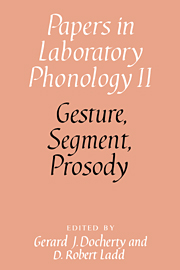Book contents
- Frontmatter
- Contents
- List of contributors
- Acknowledgments
- Introduction
- Section A Gesture
- Section B Segment
- 6 An introduction to feature geometry
- 7 The segment: primitive or derived?
- 8 Modeling assimilation in nonsegmental, rule-free synthesis
- 9 Lexical processing and phonological representation
- 10 The descriptive role of segments: evidence from assimilation
- 11 Psychology and the segment
- 12 Trading relations in the perception of stops and their implications for a phonological theory
- Section C Prosody
- Appendix 1 The test phrases (bold type) of experiment 1 in the context in which they were read
- Appendix 2 The distractors (bold type) of experiment 1 in the context in which they were read
- Appendix 3 The test sentences of experiment 2. The test words are in bold type
- Appendix 4 The distractor sentences of experiment 2. The distractors are in bold type
- References
- Name index
- Subject index
6 - An introduction to feature geometry
from Section B - Segment
Published online by Cambridge University Press: 18 December 2009
- Frontmatter
- Contents
- List of contributors
- Acknowledgments
- Introduction
- Section A Gesture
- Section B Segment
- 6 An introduction to feature geometry
- 7 The segment: primitive or derived?
- 8 Modeling assimilation in nonsegmental, rule-free synthesis
- 9 Lexical processing and phonological representation
- 10 The descriptive role of segments: evidence from assimilation
- 11 Psychology and the segment
- 12 Trading relations in the perception of stops and their implications for a phonological theory
- Section C Prosody
- Appendix 1 The test phrases (bold type) of experiment 1 in the context in which they were read
- Appendix 2 The distractors (bold type) of experiment 1 in the context in which they were read
- Appendix 3 The test sentences of experiment 2. The test words are in bold type
- Appendix 4 The distractor sentences of experiment 2. The distractors are in bold type
- References
- Name index
- Subject index
Summary
Introduction
This paper provides a short introduction to a theory which has in recent years radically transformed the appearance of phonological representations. The theory, following Clement's seminal (1985) paper, has come to be known as feature geometry. The rapid and widespread adoption of this theory as the standard mode of representation in mainstream generative phonology stems from two main factors. On the one hand, the theory resolved a debate which had been developing within nonlinear phonology over competing modes of phonological representation (and resolved it to the satisfaction of both sets of protagonists), thus unifying the field at a crucial juncture. But simultaneously, the theory corrected certain long-standing and widely acknowledged deficiencies in the standard version of feature theory, which had remained virtually unchanged since The Sound Pattern of English, (Chomsky and Halle 1968; hereafter SPE).
The theory of feature geometry is rooted firmly in the tradition of nonlinear phonology – an extension of the principles of autosegmental phonology to the wider phonological domain – and in section 6.1 I review some of this essential background. I then show, in section 6.2, how rival modes of representation developed within this tradition. In section 6.3 I consider a related problem, the question of the proper treatment of assimilation phenomena. These two sections prepare the ground for section 6.4, which shows how feature geometry successfully resolves the representation problem, and at the same time provides a more adequate treatment of assimilation.
- Type
- Chapter
- Information
- Gesture, Segment, Prosody , pp. 149 - 165Publisher: Cambridge University PressPrint publication year: 1992
- 2
- Cited by

